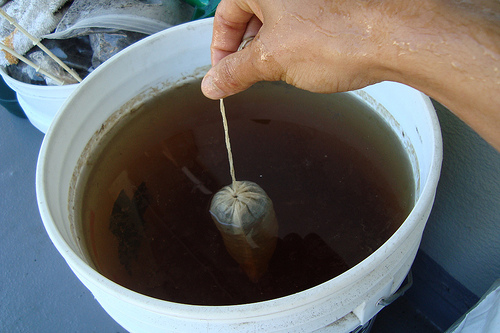Organic hydroponic solutions – meaning solutions derived from organic inputs – contain a lot of nitrogen derived from organic sources that are mainly in either ammonium or protein form. These forms of nitrogen can be useful when decomposed by microbes but can be hard for your plants to use before this decomposition process takes place. Nitrate, the form of nitrogen plants crave the most, is not easy to add directly in an organic setting, because most available nitrates are synthetic – therefore cannot be used – and mined sodium nitrate, the only one that can be used under OMRI guidelines, contains a large amount of sodium, which is not beneficial for plants. However, we can create compost teas that contain a high enough level of nitrates, that will be eagerly taken up by our plants and contain little to no sodium, starting from no mined materials.

In order to do this, we will take advantage of a research paper that was published in 2010, on the creation of nitrate-containing fertilizers from organic sources. The process takes advantage of the presence of saprophytic bacteria – those that recycle dead organisms – in several different organic materials and puts them into contact with organic inputs that are high in protein or ammonium nitrogen. With time, this creates a nitrate-rich solution that contains virtually no left-over protein or ammonium. In the paper, they tried many different organic nitrogen sources, sources of bacteria, and processing times. The process I will describe hereafter is taken from an examination of these results and what they found worked best.
The first thing we require is an organic source of nitrogen. From the many that they tried, only fish emulsion and corn steep liquor (CSL) offered high enough conversion rates into nitrate. Between these two, I would recommend using CSL, since fish emulsion can be very smelly, which can be a very important factor when large amounts are being used. The second thing we require is a source of bacteria capable of carrying out the conversion. They tried several, all with good conversion rates, but their preferred source ended up being bark compost, due to its wide availability and reproducibility.

To create the starting solution, add CSL at 1g/L and bark compost at 0.5g/L. To prepare 5 gallons of the starting solution, you would add 19g of CSL and 9.5g of bark compost. You should then connect an aeration pump into this solution, to ensure ample oxygen is available for the conversion processes. The entire process will take around 12 days. After this time has passed, you can then use this final compost tea as a nutrient solution. If you want to know what the results of your process were, I would recommend you use a nitrate ISE from Horiba which you can use to measure the final nitrate concentration of your solution. You would expect to measure around 450-600 ppm of nitrate with this meter, which would be equivalent to 100-130 ppm of N as nitrate. Since different CSL sources will have different NKP values, you might need to adjust your CSL additions to come up with better numbers. However, the above numbers should generate nitrate levels in a reasonable range.
Overall, this paper shows that a solution derived in this manner can be used to successfully grow tomatoes when compared to normal chemical fertilizers. However, note that the media did contain some amendments, as the above solution is not able to provide significant amounts of Calcium or Magnesium. Although this compost tea can provide a lot of the nutrition required, it cannot replace a full hydroponic solution when fully inert media is used. By adjusting the amount of CSL used in the process, you should also be able to control the amount of N, P, and K present in the final solution. This should allow you to create a great compost tea that can be used for the successful growing of organic hydroponic crops.





